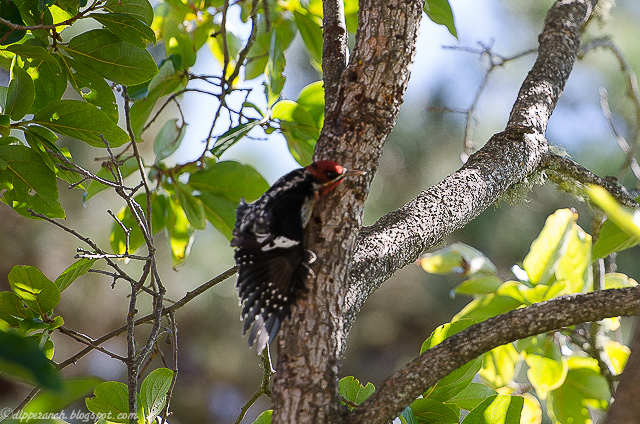 |
| A sapsucker stretches after its winter arrival at the Dipper Ranch orchard. This one looks like a cross between the red-naped sapsucker and the red-breasted sapsucker. |
Hardly any walnuts have fallen on the ground at the Dipper Ranch and they're all pecked open by birds. There will be no walnut harvest party this year. It must be the four-year drought. The walnut trees leafed out in June this year - two months late. It must be climate change.The Dipper Ranch walnut trees in December:
Here's a few thousand walnuts on the ground for you. Sorry, dropped them in their husks this year. And it's going to rain soon so you better pick them up before they mold. Isn't climate always changing?It's easy to blame everything on global climate change. The new "dog-ate-my-homework" excuse. But even before the changes to the earth's atmosphere as a result of human industrial development, California had a lot of fluctuation in its weather from year to year. Its climate is largely influenced by the shifting of a high pressure system over the northern Pacific Ocean, fluctuations in ocean surface temperatures, and the many versions of interplay between them. Were the Dipper trees so late in breaking bud and dropping walnuts this year in response to one of the natural oscillations in California's weather?
 |
| A modest but delicious harvest from two English walnut trees in 2015. Notice the series of pecked holes in the bark of these walnut trees - made by sapsuckers. |
The 2011-2015 California drought is possibly the most severe in our state in 1200 years. By studying tree-ring chronology of blue oaks and other environmental indicators, scientists believe there have been longer periods of droughts and other three-year periods with less precipitation in California, but the record high temperatures of recent years combined with the lack of precipitation caused very low soil moisture levels, a great stress on plants (Griffin and Anchukaitis, 2014).
Some scientists are now saying that higher temperatures of human-induced climate change may have contributed to this recent California drought (Williams, et al, 2015):
"Precipitation is the primary driver of drought variability but anthropogenic warming is estimated to have accounted for 8-27% of the observed drought anomaly in 2012-2014 and 5-18% in 2014. Although natural variability dominates, anthropogenic warming has substantially increased the overall likelihood of extreme California droughts."
 |
| Scrubbing the sodden husks off the walnuts. |
 |
| Drying the walnuts |
 |
| A red-breasted sapsucker waiting for rain. |
In the coast range, we've seen signs of plants responding to this most recent drought: less germination of the annual plants, earlier onset of blooming and summer dormancy, and more dead trees. The US Forest Service mapped 27 million trees which have died in California's forests in this current drought, and other scientists have detected 58 million large trees experiencing severe canopy water losses indicating stress that could result in future tree death or forest changes over 2.5 million acres in California (Ashner 2016).
 |
| Zaggy zebra-stripes across the entire back = Nuttall's woodpecker. |
 |
| Mango the cat wonders what these walnuts are doing in his territory. |
As Margaret Atwood says it, "It's Not Climate Change - It's Everything Change." Although she is describing the social impacts of climate change on a global scale, the recent California drought is mentioned twice in her cleverly illustrated article.
------------------------------
D. Griffin and K. J. Anchukaitis, 2014, How Unusual is the 2012-2014 California Drought?, Geophysical Research Letters, 41, 9017-9023.
A. Williams, A.P.R. Seager, J.T. Abatzoglou, B.I. Cook, J.E. Smerdon, and E. R. Cook, 2015, Contribution of Anthropogenic Warming to California Drought During 2012-2014, Geophysical Research Letters, 42, 6819-6828.
Gregory P. Asner, Philip G. Brodrick, Christopher B. Anderson, Nicholas Vaughn, David E. Knapp, and Roberta E. Martin, 2016, Progressive forest canopy water loss during the 2012–2015 California drought, Proceedings of the National Academy of Sciences 113: E249-E255.
Margaret Atwood, July 27, 2015, It's Not Climate Change - It's Everything Change.
Some other California climate change sources:
Climate News Archive, California Department of Water Resources
Climate of California, Western Regional Climate Center
Indicators of Climate Change in California - Report Summary, California Office of Environmental Health Hazard, August 2013
California's Most Significant Droughts: Comparing Historical and Recent Conditions, California Department of Water Resources, February 2015.
Tens of Millions of Trees in Danger From California Drought, The Carnegie Airborne Observatory.
I was wondering what had happened to the annual walnut harvest!
ReplyDeleteI like snakes and the annual contest and this informative blog!
ReplyDeleteMom said: "Every year is a normal year in California"
ReplyDeleteShe also said all her friends showed everyone their hands to show the black from picking walnuts.